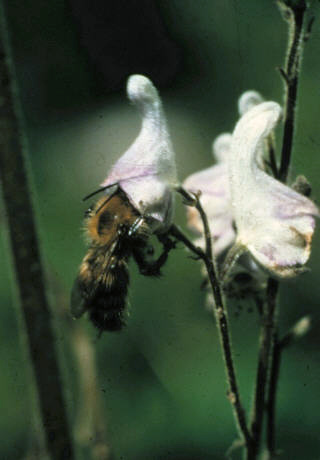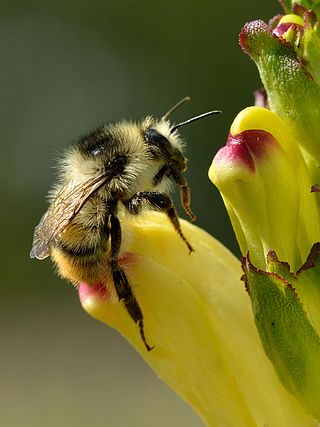Bombus is the genus that includes the bumblebee.
Bombus may also refer to:
- Bombus (band), a Swedish speed/heavy metal band
- Bombus (album), 2010
Bombus is the genus that includes the bumblebee.
Bombus may also refer to:

A bumblebee is any of over 250 species in the genus Bombus, part of Apidae, one of the bee families. This genus is the only extant group in the tribe Bombini, though a few extinct related genera are known from fossils. They are found primarily in higher altitudes or latitudes in the Northern Hemisphere, although they are also found in South America, where a few lowland tropical species have been identified. European bumblebees have also been introduced to New Zealand and Tasmania. Female bumblebees can sting repeatedly, but generally ignore humans and other animals.
Apparatus may refer to:

Bombus terrestris, the buff-tailed bumblebee or large earth bumblebee, is one of the most numerous bumblebee species in Europe. It is one of the main species used in greenhouse pollination, and so can be found in many countries and areas where it is not native, such as Tasmania. Moreover, it is a eusocial insect with an overlap of generations, a division of labour, and cooperative brood care. The queen is monogamous which means she mates with only one male. B. terrestris workers learn flower colours and forage efficiently.

The early bumblebee or early-nesting bumblebee is a small bumblebee with a wide distribution in most of Europe and parts of Asia. It is very commonly found in the UK and emerges to begin its colony cycle as soon as February which is earlier than most other species, hence its common name. There is even some evidence that the early bumblebee may be able to go through two colony cycles in a year. Like other bumblebees, Bombus pratorum lives in colonies with queen and worker castes. Bombus pratorum queens use aggressive behavior rather than pheromones to maintain dominance over the workers.

Bombus consobrinus is a species of bumblebee found in Hungary, northern Scandinavia, Kazakhstan, Russia, China, North and South Korea, and Japan.

Bombus sylvarum, the shrill carder bee or knapweed carder-bee, is a species of bumblebee with a wide distribution across Europe, east to the Ural Mountains, and north to Great Britain, Ireland, and southern Scandinavia.

The brown-banded carder bee is a bumblebee found in most of Europe west of Russia, with the exception of Ireland and Iceland. It is also found in Turkey, on the Tibetan plateau, northern China, eastern and southern Mongolia, and parts of North Korea. In Britain, it is limited to the coast and chalkland areas of southern England. The brown-banded carder bee is similar in appearance to the moss carder bee. As they share similar habitats, care must be taken to distinguish between the two.

Bombus ruderatus, the large garden bumblebee or ruderal bumblebee, is a species of long-tongued bumblebee found in Europe and in some parts of northern Africa. This species is the largest bumblebee in Britain and it uses its long face and tongue to pollinate hard-to-reach tubed flowers. Bumblebees are key pollinators in many agricultural ecosystems, which has led to B. ruderatus and other bumblebees being commercially bred and introduced into non-native countries, specifically New Zealand and Chile. Since its introduction in Chile, B. ruderatus has spread into Argentina as well. Population numbers have been declining and it has been placed on the Biodiversity Action Plan to help counteract these declines.
The term carder bee is a popular name applied to various bees, including:

Bombus centralis, the central bumblebee, is a species of bumble bee found in parts of Canada and the western United States. The species was first described by Ezra Townsend Cresson in 1864.

Bombus are a heavy metal band from Gothenburg, Sweden. Bombus initially signed to Mourningwood Recordings, releasing 3 singles and their debut album Bombus before signing to Century Media on 10 April 2013; releasing another single "Apparatus", on 6 May 2013, and their second studio album The Poet and the Parrot on 26 September 2013.

"Apparatus" is a song by Swedish heavy metal band Bombus, it was released as a single from their second studio album The Poet and the Parrot, on digital download and on 7" vinyl limited to 500 copies.

Bombus terricola, the yellow-banded bumblebee, is a species of bee in the genus Bombus. It is native to southern Canada and the east and midwest of the United States. It possesses complex behavioral traits, such as the ability to adapt to a queenless nest, choose which flower to visit, and regulate its temperature to fly during cold weather. It was at one time a common species, but has declined in numbers since the late 1990s, likely due to urban development and parasite infection. It is a good pollinator of wild flowers and crops such as alfalfa, potatoes, raspberries, and cranberries.
Apicystis is a genus of parasitic alveolates of the phylum Apicomplexa.

Bombus griseocollis is a species of bumblebee known commonly as the brown-belted bumblebee. It is native to much of the United States except for the Southwest, and to the southernmost regions of several of the provinces of Canada.
Yellow bumblebee is a common name for several insects and may refer to:

Bombus californicus, the California bumble bee, is a species of bumble bee in the family Apidae. Bombus californicus is in the subgenus Thoracobombus. It is found in Central America and the western half of North America. Bombus californicus is classified as Vulnerable by the IUCN.

Bombus mesomelas is a species of bumblebees.